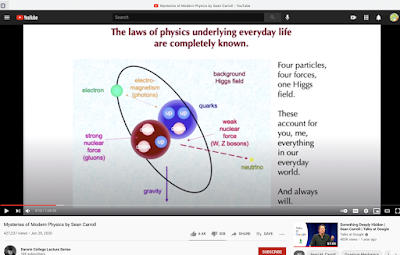YOU HAVE GOT TO BE JOKING. Hoffman’s book and idea is a total snow job! I am profoundly disappointed write4u.
Content
Cc’s Students’ Study Guide for The Case Against Reality .
(a non-scholar’s “scholarly” effort)

I intend to be a witness for a fact based Deep Time,
Evolutionary perspective on our Human Mind ~ Physical Reality interface.
Donald Hoffman Playing Basketball in Zero-Gravity ,
a critical review of, The Case Against Reality: Why Evolution Hid The Truth From Our Eyes, by Donald Hoffman, ©2019, W.W.Norton Company
(Titles are linked)
(1.01) The Prelude, Prof Donald Hoffman Playing Basketball In Zero-Gravity
(1.02) Chapter 10a, Community: Network of Conscious Agents (1/3)
(1.03) Chapter 10b, Community: Network of Conscious Agents (2/3)
(1.04) Chapter 10c, Community: Network of Hoffmanian Conscious Agents (3/3)
(1.05) Chapter 1, Mystery: The Scalpel That Split Consciousness
(1.06) Chapter 2, Beauty: Siren of the Gene
(1.07) Chapter 3, Reality: Capers of the Unseen Sun
(1.08) Chapter 4, Sensory: Fitness beats Truth
(1.09) Chapter 5, Illusory: The Bluff of the Desktop
(1.10) Chapter 6, Gravity: Spacetime is Doomed
(1.11) Chapter 7, Virtuality: Inflating a Holoworld
(1.12) Chapter 8, Polychromy: Mutations of an Interface
(1.13) Chapter 9, Scrutiny: You Get What You Need, in Both Life and Business
(1.14) Appendix, Precisely: The Right to Be (Foolish)
Hoffman/Prakash’s Objects of Consciousness , Objections and Replies
Frontiers in Psychology - June 17, 2014
(2.01) 4/4_Hoffman, Objects of Consciousness, (conclusion)
(2.02) 1/4_Hoffman, Objects of Consciousness, questions + replies (1-12)
(2.03) 2/4_Hoffman, Objects of Consciousness, questions + replies (13-17)
(2.04) 3/4_Hoffman, Objects of Consciousness, questions + replies (18-21)
(3.01) Diary - But, wait! There’s more. Ten Learned Responses :
“ Probing the interface theory of perception: Reply to commentaries , by Donald D. Hoffman, Manish Singh & Chetan Prakash"
Psychonomic Bulletin & Review . volume 22, pages1551–1576(2015)
Abstract
We propose that selection favors nonveridical perceptions that are tuned to fitness. Current textbooks assert, to the contrary, that perception is useful because, in the normal case, it is veridical. Intuition, both lay and expert, clearly sides with the textbooks. We thus expected that some commentators would reject our proposal and provide counterarguments that could stimulate a productive debate. … (HSP)
(3.02) Barton Anderson - Where does fitness fit in theories of perception?
doi:10.3758/s13423-014-0748-5
(3.03) Jonathan Cohen - Perceptual representation, veridicality, and the interface theory of perception.
doi:10.3758/s13423-014-0782-3
(3.04) Shimon Edelman - Varieties of perceptual truth and their possible evolutionary roots.
doi:10.3758/s13423-014-0741-z
(3.05) Jacob Feldman - Bayesian inference and “truth”: a comment on Hoffman, Singh, and Prakash.
doi:10.3758/s13423-014-0795-y
(3.06) Chris Fields - Reverse engineering the world: a commentary on Hoffman, Singh, and Prakash, “The interface theory of perception”.
doi:10.3758/s13423-014-0742-y
(3.07) Jan Koenderink - Esse est Percipi & Verum est Factum.
doi:10.3758/s13423-014-0754-7
(3.08) Rainer Mausfeld - Notions such as “truth” or “correspondence to the objective world” play no role in explanatory accounts of perception.
doi:10.3758/s13423-014-0763-6
(3.09) Brian P. McLaughlin and E. J. Green - Are icons sense data ?
doi:10.3758/s13423-014-0780-5
(3.10) Zygmunt Pizlo - Philosophizing cannot substitute for experimentation: comment on Hoffman, Singh & Prakash.
doi:10.3758/s13423-014-0760-9
(3.11) Matthew Schlesinger - Interface theory of perception leaves me hungry for more.
doi:10.3758/s13423-014-0776-
Student Resources - Background info:
(4.01) Rainer Mausfeld : ‘Truth’ has no role in explanatory accounts of perception.
(4.02) Paul Mealing : considers Hoffman’s "Objects of Consciousness.”
(4.03) The Case For Reality : Because Apparently Someone Needs to Make One
(4.04) Sabine Hossenfelder : in Defense of Scientific Realism and Physical Reality
(4.05) “Emergence” - A Handy Summary and Resources
(4.06) Physical Origins of Mind: Dr. Siegel , Allen Institute Brain Science, Tononi, Koch .
(4.07) Can you trust Frontiers in Psychology research papers ? Student Resource
(4.08) Critical Thinking Skills - In Defense of Reality - A Student Resource
(4.09) Philo+Sophia - Love of Wisdom - A Student Resource
(5.01) Summary,
explaining why I’ve pursued this project.
Dr. Mark Solms deftly demystifies Chalmers’ “Hard Problem” of Consciousness, while coincidentally highlighting why Hoffman’s “Conscious Agents” are luftgeschäft.
(6.01) Dr. Mark Solms demystifies Chalmers’ “Hard Problem” of Consciousness.
(6.02) The Other Side of Mark Solms PhD, farmer, vintner, humanitarian.
(6.03) Students’ Resource: A representative cross-section of Dr. Mark Solms’ scientific publications.
My homemade philosophical underpinnings.
(7.01) An Alternative Philosophical Perspective - “ Earth Centrism ”
(7.02) Appreciating the Physical Reality ~ Human Mindscape divide
(7.03) Being an element in Earth’s Pageant of Evolution
(7.04) It’s not a “ Body-Mind problem ” it’s an “ Ego-God problem .”
Feel free to copy and share
confrontingsciencecontrarians.blogspot.com
Email: citizenschallenge gmail com
The bottom line, courtesy of:
Mysteries of Modern Physics by Sean Carroll
Jan 29, 2020 - Darwin College Lecture Series

Sean Carroll, 10:45
. . . these are the particles that make up you and this table and me and this laptop and really everything that you have ever seen with your eyes touched with your fingers smelled with your nose in your life.
Furthermore we know how they interact with each other and even better than that, the most i mpressive fact is that there will not be a discovery tomorrow or next century or a million years from now which says you know what there was another particle or another force that we didn’t know about but now we realize plays a crucial role in our everyday life.
As far as our everyday life is concerned by which I really mean what you can see with your eyes touch with your hands etc we’re done finding the underlying ingredients. That is an enormous achievement in human history one that does not get enough credit, because of course as soon as we do it we go on to the next thing.
Physics is not done. I’m not saying that physics is done, but physics has understood certain things and those things include everything you encounter in your everyday life - unless you’re a professional experimental physicist or unless you’re looking of course outside our everyday life at the universe and other places where we don’t know what’s going on. …


